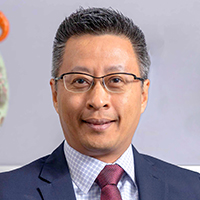Making business easier: Cutting-edge treasury for seamless trade
How can multiplying challenges be overcome to make trade less complicated? The answer, like trade itself, is constantly evolving. In this first of two articles, Bank of America’s George Fong, APAC head of trade and supply chain finance, and Olivier Anceau, APAC head of specialized product sales, reveal how innovative solutions can simplify operations, boost resilience and empower treasurers to thrive in complex trade corridors.
15 minute read
It's clear that the recent and ongoing macro events are creating new and unwelcome trade headwinds for businesses in APAC and around the world. With market uncertainty rife across the globe, current geopolitical hotspots and U.S. tariffs are impacting not only how trade flows are physically moving but also how the supplier market is changing.
Pricing volatility and political tensions are disrupting markets, causing businesses to rethink their physical and financial supply chain approach, with new trade corridors and relationships being forged into existence.
Add in the general economic downturn striking at the heart of large consumer markets, and Fong sees consumption patterns now driving changes in domestic and import trade activity. This is exacerbated by the energy market turmoil, which has driven up the cost of production and transportation of goods across the trading world.
Of course, treasurers are fully aware of these events, and would already have had to attend to their financial impact one way or another. “Those businesses that have chosen to build in more trade resiliency will have been obliged to consider how they maintain and manage their cost base, as well as their manufacturing and inventory bases,” notes Fong.
The move from “just-in-time” to “just-in-case” inventory models has elevated the costs for purchasing, manufacturing, and warehousing. Meanwhile, businesses are prioritizing secured supply chains over cost, embracing re-shoring, near-shoring, and friend-shoring. “Geopolitics is reshaping supply chain stability and market awareness,” Fong explains, highlighting the need for resilient trade partnerships.
Categorize, prioritize, stabilize
As buyers and suppliers seek to steady the ship amid trading turmoil, partner selection will have an increasingly important role to play, says Fong. “The importance of banks being able to provide clients with stability in their supply chains financing and working capital cycle is amply clear,” he explains. “But at Bank of America, we also recognize the need to make it easier for our clients to do business in the current environment. We can do that by offering intuitive tools that streamline trade processes, are easy to implement, provide deeper integration and have a range of options for payments and settlement.”
So how does the pledge to make life easier for trade participants translate into the Bank of America product set? In the first instance, Fong points to the bank’s dynamic CashPro® Supply Chain Solutions, launched in 2023. This includes Open Account Automation (OAA) and Corporate Payment Undertaking (CPU), designed to ease treasury burdens.
OAA transforms the order-to-pay cycle, leveraging Natural Language Processing (NLP) and Application Programming Interface (API) connectivity to process invoice data swiftly. “OAA cuts invoice approval and payment times from days or weeks to minutes,” Fong says, optimizing working capital and stabilizing supply chains.
A recently introduced iteration of Bank of America’s classical SCF offering is the CPU. This facilitates a discounted early supplier payment by the bank, based on an undertaking – an indemnity – from its buyer client to pay on the due date.
“The subtle difference between CPU and a conventional SCF is that since we have an undertaking from the buyer, we are not reliant on the need to onboard the suppliers, there is no KYC or legal documentation to be signed, and we are not purchasing the receivables,” Fong reveals.
A system implementation with the buyer into Bank of America’s CashPro Trade platform is required. However, Fong points out the ease of set up supports a “rapid program ramp-up.” Indeed, with no minimum supply qualification, even smaller suppliers can be quickly onboarded. “The flexibility and ease of onboarding means our buyer clients can pivot very easily into new markets.”
To further assist the program setup, the bank has a dedicated supplier onboarding team working in tandem with the client from day one. The aim is to categorize and prioritize each supplier need. Client feedback on CPU has already confirmed the benefits. Fong says that one client, in the technology and software space, reported that the “considerably lighter onboarding process” enabled it to bring a number of IT suppliers in China and India into the program in just one week.
Alongside OAA, the CPU unlocks end-to-end processing, from automated invoice and purchase order matching, all the way to the discounting option. “This is about providing significantly more trade ease for our clients. In doing so, we are supporting their working capital financing, and ultimately helping to create the stability that trade participants desperately need now.”
With these new solutions, Bank of America is clearly upbeat on reimagining trade finance. But there is still a role for conventional SCF, Fong insists. Indeed, he explains that the bank has now fashioned a hybridized version of SCF for one client. Spanning several markets, this business requested the bank to continue with its conventional SCF solution in certain territories, but still wanted the option to offer CPU where it was felt to be more advantageous. This, Fong comments, “demonstrates both the need and the will for banks to be flexible, even with traditional offerings.”
Must-have versus nice-to-have
Many treasurers are struggling to even meet their “must-have” priorities – such as liquidity and cash visibility, and reporting and compliance – let alone their “nice-to-have” value-creation aims, notes Anceau. “Technology is often said to be the answer, and yet all too often, treasuries simply do not have the time, money or the resources to implement the solutions that could provide relief. And more often than not, their own technology infrastructure is not ready to adopt some of these solutions.”
For this reason, Bank of America’s approach to solution development is informed by a “light touch” implementation philosophy, realized via its global CashPro platform. “And all the investment and development work going into CashPro are driven by our clients,” states Anceau.
Engaging clients in conversations about real-world challenges is a key part of the bank’s support of treasury’s continued evolution. Until COVID-19 struck the world, the treasury approach to digitization was often held back by lack of resources, recalls Anceau. Out of sheer necessity, the pandemic drove a huge acceleration in uptake so that today, he sees many companies have developed strong basic digital capabilities around their must-have treasury functions.
Now, with the nice-to-have functionalities often powered by new technologies, once again, Anceau sees the pace of adoption typically being guided by resource availability, and this has promoted a “wait-and-see” approach. For treasury teams to benefit from these solutions, it’s clearly down to banks and vendors to understand all of the client challenges and opportunities and then make solution implementation as easy as possible.
All under one umbrella
The CashPro global platform is now a one-stop shop for trade functionality. “Clients do not need to request additional implementation work,” states Anceau. As an example, CashPro Trade facilitates client management of all trade and SCF on a single global platform, with every aspect that can be digitized, being made available to users.
Also under the CashPro umbrella is CashPro Insights. A development of the CashPro Data Intelligence product suite, Insights is steered by a need to help clients in an advisory as well as a practical capacity, CashPro Insights aims to support “smart and efficient decision-making,” says Anceau. Insights as a suite is about payments processes or liquidity management, for example, but the goal is always to facilitate “a better understanding of what clients should be doing, not just what they are doing.”
A key offering that is complemented by CashPro Insights is CashPro Forecasting. Anceau explains that this uses artificial intelligence (AI) and machine learning (ML) to analyze historical cash flows to offer more accurate forecasting. The system has its own what-if and scenario-based models, which can be augmented by the user’s own algorithms. “If new U.S. tariffs are being announced for a certain country, and the treasurer knows that this will impact their local cashflow, they can set up and analyze different scenarios, and potentially use CashPro Insights to help steer their best course of action.”
The idea behind the bank’s Intelligent Receivables (IREC) platform – to assist clients with automated reconciliations and bringing payment and remittance data together – is another tool underpinned by AI and ML. “We know, for many our clients, this is still a manually intensive process, even if it has been centralized in their Shared Service Center (SSC),” says Anceau. “With IREC, we can help deliver a reduction in their Days Sales Outstanding (DSO) and provide the ability to automate the entire reconciliation process.”
The CashPro team has also brought to the table the Guaranteed FX Rates offering. Transactional FX clients can, with no additional technology changes, secure guaranteed FX rates for smaller-ticket flows for up to one year out. When it was launched in October 2024, this was the longest tenor available in the industry. “In the current environment, as clients deal with more currencies and more volatile cash flows, this delivers a huge benefit because it enables treasury to focus more on risk management for their larger transactions,” comments Anceau.
A solid core
Treasurers often face resource constraints, limiting their ability to adopt new solutions. Post-COVID, treasuries have bolstered digital capabilities for core functions. However, adopting advanced tools remains challenging due to resource limitations. Anceau reveals that uptake of the bank’s solution set is on the rise. But clients not only recognize the value of these offerings but also are now technologically ready. “Having rolled out new versions of their ERPs, having centralised into SSCs, and increasing numbers having implemented a TMS, their core technology readiness compared with 10 or even five years ago has evolved significantly.”
While different markets will evolve at different rates, demanding the need for existing and new solutions to run concurrently, the uptake of platforms such as IREC is increasingly healthy, and is expected to continue as such for some time, notes Anceau.
The promise of real-time data exchanges, and in particular the use of APIs as a means of delivery, is also exhibiting strong growth. However, Anceau notes that this tends to be focused on a relatively small number of players in certain digital native sectors such as technology and non-bank financial institutions.
Talk now, don’t wait and see
Some treasurers adopt a “wait-and-see” stance on emerging technologies, but Anceau urges immediate action. “Don’t wait for the next crisis to explore these solutions,” he advises. Proven tools like OAA, CPU, and IREC deliver instant value, helping treasurers stay competitive in a volatile trade environment.
Of course, that wait-and-see mentality has its place when considering emerging technologies – after all, a number of the “latest and greatest” ideas have fallen by the wayside. However, all of the solutions considered above can already be seen in action, delivering clear value to clients.
With the intensity of competition in a stressed trading environment ramping up seemingly on a daily basis, Fong makes final observations.
“Every bank knows that there is a need for stability, visibility, and cash resilience among their corporate clients. And most offer solutions that can tackle certain aspects of this. But it is important to have a banking partner that is willing to work with clients on a dynamic basis, guiding clients through their unique challenges.”
Fong asserts that Bank of America’s solutions are easy to adopt and tailored to the evolving needs of clients. This is the critical difference: A bank tries to make it easier for clients to do business, especially as trade challenges intensify. Partnering with a bank that prioritizes ease and adaptability is essential for long-term success.
This article was first published on TMI.

Olivier Anceau | Head of Specialized Product Sales APAC, Global Payments Solutions, Bank of America

George Fong | Head of Trade and Supply Chain Finance APAC, Global Payments Solutions, Bank of America
Global Trade and Supply Chain Finance
View a range of solutions to help you optimize working capital and manage risk



